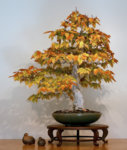There’s a pretty epic Beech yamadori in the woods near me. It’s on private land so I need to get permission, fingers crossed. Fairly certain it’s Fagus grandifolia, American Beech, as they’re pretty common wild here. The tree is pretty big for bonsai, about 4’. But a really epic main leader that twists and curves. I’m wondering, if collected, how much of the roots can these handle being removed? The less of a root ball there is the more doable it will be for retrieval. Finally, what’s an ideal time for collection?
That you're using height to describe the tree indicates you're probably not experienced enough to get it out alive. That sounds harsh and judgmental (and some will undoubtedly say "go for it--that guy's being an
A@#$$%^, but if you really want the tree for bonsai, I'd advise getting some prior experience with some less impressive beech living NEAR the tree you ultimately want. You will wind up killing it and wasting choice material.
We're well past collection season for this year. Dig it now and it will definitely die on you. Collection season in your area is probably late next March or so, but I would check on this LOCALLY not on the Internet. Getting collection advice from someone 500, 1,000 miles, or 10,000 miles away from your area is a hit or miss proposition.
When it does come I'm with Zach. I would containerize it. I don't like having to collect trees twice. To get any benefit from in-ground growing you will have to leave it alone for at least two years. Lifting it before then will provide no benefit at all and will probably set you back by weakening the tree even further. Beech are extremely conservative trees--they grow slowly.
For inspiration--one of the best Fagus Grandifolia bonsai I've ever seen. National Bonsai and Penjing Museum in D.C. In training since 1979, owner Fred Mies gave it to the collection in 2003. The tree was dug in the mid-Atlantic region, I think in Maryland. Note it is not "spectacular" in the sense of extremes. Beech is a quieter tree visually. Lots of gimmicks like dead wood, funky trunks and roots don't work well with it...Just my opinion.




